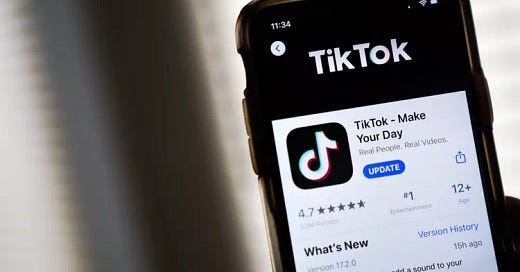Bonus 113: Tick Tock for TikTok
The justices' decision to hear expedited argument on the constitutionality of the TikTok statute makes a lot of sense. It's also a good foil for a broader debate about when / how the Court intervenes.
Welcome back to the weekly bonus content for “One First.” Although Monday’s regular newsletter will remain free for as long as I’m able to do this, much of the bonus content is behind a paywall as an added incentive for those who are willing and able to support the work that goes into putting this newsletter together every week. I’m grateful to those of you who are already paid subscribers, and hope that those of you who aren’t will consider a paid subscription if and when your circumstances permit:
The focus of today’s post is, quite obviously, yesterday’s order from the Supreme Court granting certiorari (and expediting the heck out of briefing and argument) in the TikTok case—in which the justices will decide the constitutionality of a statute requiring U.S. companies to cease providing any support for the popular app unless its Chinese owners divest by January 19. Indeed, when yesterday’s order came down, I had already written what was going to be today’s post—previewing the two emergency applications seeking to block enforcement of the anti-TikTok statute while its constitutionality was appealed—in which I had suggested that the justices split the baby exactly as they have, by granting plenary review and holding an expedited argument without granting the two applications for an injunction pending appeal.
Now that that’s been preempted, I thought I’d use today’s post to explore two points in reaction to what the Court has actually done. The first, as alluded to above, is why, procedurally, I believe that the Court got this one right. I spend a lot of time in this newsletter and elsewhere criticizing the justices when I think that they’re taking procedural shortcuts or otherwise not showing proper fealty to their own standards, rules, and norms. But it’s also important to say when I think they handled a big case by the book—and this strikes me as that.
The second, related point is about why reaching the merits on expedited plenary review here makes more sense than the alternatives—but why that’s not necessarily true in other cases. Indeed, I’ve been quite critical of the Court’s tendency in recent years to reach the merits at increasingly preliminary (if not premature) stages of litigation—culminating in my hot-off-the-presses article, “A Court of First View,” in this month’s Harvard Law Review. But there are unique, idiosyncratic features of the TikTok case, most of which can be traced to the way Congress wrote the statute at issue, that made truncated judicial review effectively unavoidable here. Thus, it’s worth articulating (because the Court likely never will) why the TikTok case, in particular, warranted this kind of expedited merits review—but why the typical case, even if it’s a high-profile, nationally important dispute, shouldn’t.
For those who are not paid subscribers, the next free installment of the newsletter will drop on Monday morning. For those who are, please read on.
Keep reading with a 7-day free trial
Subscribe to One First to keep reading this post and get 7 days of free access to the full post archives.




